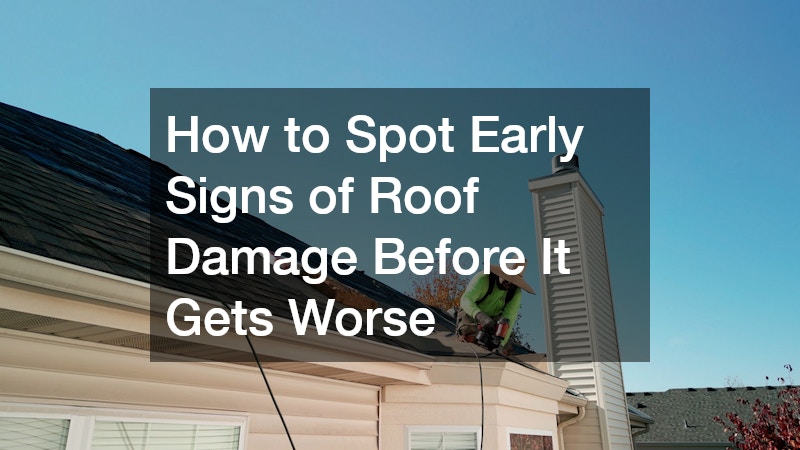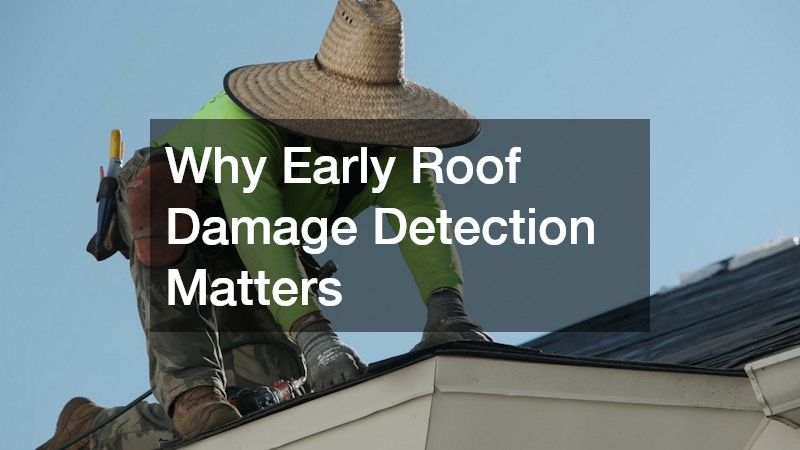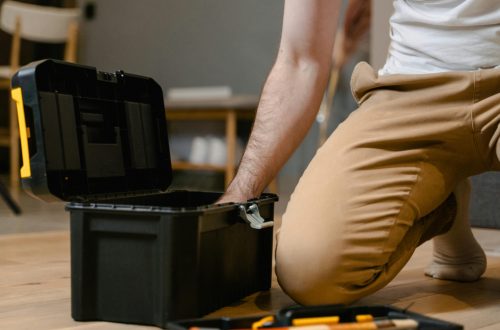
- Discoloration, curling, or missing shingles often signal roof trouble.
- Interior water stains or mold growth can indicate hidden leaks.
- Sagging or warped rooflines suggest serious structural issues.
- Gutter clogs and granule buildup point to shingle wear.
- Seasonal inspections can catch issues before they require major repairs.
- Quick fixes should be followed by professional evaluations.
- Calling a roofing company with great reviews ensures safe and lasting repairs.
Your roof plays a critical role in protecting your home from weather, water, and temperature extremes. When roof damage goes unnoticed, small issues can quickly turn into expensive repairs or even full replacements. Fortunately, you don’t have to be a roofing expert to catch early warning signs. With a keen eye and some basic knowledge, homeowners can prevent thousands of dollars in water damage and structural repairs.
Common Visual Signs of Roof Damage
Visual inspections are your first line of defense against expensive roof repairs. Ideally, inspect your roof at least twice a year—once in the spring and again in the fall. You should also do a quick check after any major storm. Early detection can prevent water damage, energy loss, and costly structural issues.
Here are some of the most common visible signs that your roof might be in trouble:
- Curling or Cracked Shingles
Shingles are your roof’s first barrier against the elements. When they begin to curl, crack, or lift, their protective ability weakens significantly.
What to look for:
- Curling edges: Often caused by heat exposure or aging asphalt. Curled shingles can easily be blown off by strong winds.
- Cracks across the shingle surface: These often result from temperature fluctuations or poor attic ventilation.
- Lifted shingles: Indicate deteriorated adhesive strips or damage from wind or moisture.
Why it matters: Shingles in this condition allow water to seep into the layers below. Over time, this can lead to:
- Internal water damage
- Insulation problems
- Mold and mildew in the attic
If more than a few shingles are affected, it’s time to call a professional roofer to assess the extent of the damage.
- Missing or Loose Shingles
A few missing shingles might not seem like a big deal, but they can expose vulnerable areas of your roof to rain, UV rays, and pests.
Common causes:
- High winds from storms or hurricanes
- Improper installation
- Aged roofing adhesive that no longer holds
Risks of ignoring missing shingles:
- Leaks: Water can enter through exposed underlayment.
- Mold growth: Moisture trapped inside can spread through insulation and wood framing.
- Structural damage: Over time, rotting wood weakens the roof deck.
Tip: Check for shingle pieces in your gutters or around your yard—these can be clues even if you can’t see the missing sections from the ground.
- Discoloration or Dark Patches
Roof stains are more than just cosmetic concerns. Dark streaks, green patches, or uneven coloring often signal trapped moisture, biological growth, or ventilation issues.
Possible causes:
- Algae or moss: Frequently found in humid or shaded areas, especially on north-facing slopes.
- Water pooling: Often caused by improper drainage or sagging roof sections.
- Age-related granule loss: Can expose the asphalt layer beneath, causing color shifts.
What it can lead to:
- Decreased roof lifespan
- Increased energy bills due to poor reflectivity
- Mold and mildew spreading into your home’s structure
Maintenance tip: Have a professional inspect and clean your roof to determine whether discoloration is surface-level or a sign of deeper issues.
- Granules in Gutters or Downspouts
Granules are the sand-like coating on asphalt shingles that protect them from UV rays. Finding them in your gutters is a warning sign.
When this happens:
- During the first year after installation (minor shedding is normal)
- As shingles near the end of their lifespan
- After intense weather like hailstorms or heavy rain
Why it’s a problem:
- Loss of granules exposes shingles to faster deterioration
- Speeds up roof aging and increases the likelihood of cracks and leaks
- Affects the roof’s appearance and performance
Pro tip: Check the gutter downspout for granule buildup a few times a year, especially after storms.
- Sagging Roof Lines
Your roof should have a straight and even profile. If you notice areas where the roofline dips or sags, this could be a major structural warning.
Likely causes:
- Water damage: Prolonged leaks can rot the roof decking.
- Excessive weight: From snow, debris, or multiple layers of roofing.
- Framing issues: Poor construction or damaged support beams.
Consequences of ignoring a sag:
- Total roof collapse in extreme cases
- Increased repair costs due to structural damage
- Safety hazards for people living in the home
Don’t wait—have sagging areas inspected immediately by a qualified roofing contractor.
- Damaged Flashing or Roof Vents
Flashing and vents are often overlooked, but they play a vital role in preventing leaks where the roof meets vertical surfaces.
Check for:
- Rust or corrosion on metal flashing
- Cracks or broken seals around vent pipes or skylights
- Loose flashing near chimneys or dormers
Why it matters: Compromised flashing allows water to seep into seams, leading to hidden leaks and mold behind walls and ceilings.
If caught early, flashing issues can usually be repaired without replacing large roof sections.
- Moss and Vegetation Growth
While moss might give a charming look to a cottage roof, it’s a red flag for modern roofing systems.
What it signals:
- Excess moisture retention
- Shaded or poorly drained areas
- Inadequate airflow or roof slope
Risks of unchecked growth:
- Moss holds water against shingles, causing them to degrade
- Root systems can lift and separate shingle layers
- Eventually leads to leaks and wood rot
How to address it:
- Clean gently with a moss-removing solution or hire a professional
- Trim nearby trees to improve sunlight exposure
- Improve attic ventilation and drainage systems
Signs Inside the House That Point to Roof Problems
Roof issues don’t just affect the exterior of your home—they can show up inside too. Check the following:
1. Water Stains on Ceilings or Walls
Brown, yellow, or grayish stains are a red flag that water is seeping in. Common causes include:
- A leak in the roof or flashing
- Poor attic insulation
- Ice dams in colder climates
The longer water stains are ignored, the higher the chance of mold growth or ceiling collapse.
2. Mold or Mildew Smell in the Attic
Your attic is one of the first places to check for roof leaks. Musty smells may be due to:
- Trapped moisture
- Improper ventilation
- Persistent condensation
Inspect for any discoloration, especially around beams or insulation.
3. Dripping or Damp Insulation
If insulation feels wet or compressed, it likely isn’t working properly—and moisture from a leaky roof is the probable cause. This issue can increase energy costs and damage structural components over time.
Gutter and Drainage Clues
Gutters play a key role in protecting your roof from water damage. If they aren’t functioning properly, water can back up under shingles or pool near the foundation.
Warning Signs in Your Gutters:
- Granule Buildup: Asphalt shingles shed granules as they age. A heavy layer of granules in your gutters means the shingles are nearing the end of their life.
- Clogs and Overflowing Water: Leaves, dirt, and other debris can block water flow, leading to roof and fascia board damage.
- Detached or Sagging Gutters: If gutters pull away from your home, water may be damaging the fascia or underlying wood.
Clean your gutters regularly and inspect them for structural soundness during each cleaning.
Structural Signs You Shouldn’t Ignore
Some of the most serious roof issues show up in the shape and feel of the roof itself. Don’t overlook the following red flags:
1. Sagging Roofline
A sagging or uneven roof could mean:
- Compromised trusses or decking
- Excess weight from snow, water, or layers of old roofing
- Long-term moisture damage
This is not a DIY fix—contact a professional immediately.
2. Soft Spots or Spongy Areas
When walking on the roof (only if it’s safe and necessary), pay attention to how it feels underfoot. Spongy areas may indicate rot or water-damaged decking.
3. Loose Flashing or Roof Vents
Flashing is the metal used around chimneys, vents, and valleys. If it’s rusted, detached, or bent, water can seep into these vulnerable areas.
How Weather Impacts Roof Damage
Weather is one of the leading causes of roof wear and tear. Understanding how it affects your roof helps with early detection and long-term planning.
Common Weather-Related Issues:
- Wind Damage: Lifts or tears shingles.
- Hail: Cracks or dents shingles and flashing.
- Ice Dams: Trap water under shingles in winter.
- Sun Exposure: Breaks down shingles over time, especially in hotter climates.
Schedule roof checks after major storms or extreme temperature shifts to spot new damage early.
Seasonal Roof Maintenance Tips
Regular maintenance helps extend the life of your roof and reduces the risk of unexpected problems.
Spring & Fall Roof Maintenance:
- Clean gutters and downspouts.
- Trim overhanging branches that may damage shingles.
- Check attic insulation and ventilation.
- Inspect flashing, vents, and skylights.
- Look for signs of pest infestation like droppings or nests.
Document your findings with photos to monitor changes over time. Keeping records also helps if you file a warranty claim or insurance report later.
When to Call a Professional
Even with regular inspections, some issues are difficult to diagnose without experience. That’s when a qualified roofer becomes essential.
Choose a Roofing Company with Great Reviews
Look for companies that:
- Have verified online testimonials
- Are licensed and insured
- Offer free or low-cost inspections
- Provide warranties on materials and labor
A roofing company with great reviews is more likely to deliver quality work and transparent service. Avoid door-to-door “storm chasers” who may not offer lasting solutions.
Temporary Fixes vs. Permanent Repairs
Some roof issues need immediate attention to prevent further damage, even if the full repair can’t happen right away.
Temporary Measures:
- Tarp over leaks: Prevent water intrusion until repairs are made.
- Apply roofing sealant: Good for small cracks or nail holes.
- Reattach loose shingles: Use roofing nails if safe to access.
Permanent Solutions:
- Full shingle replacement
- Structural reinforcement
- Roof ventilation upgrades
Always follow up temporary fixes with a full inspection and long-term plan.
Mistakes to Avoid When Inspecting Your Roof
Self-inspections can be useful, but they’re not foolproof. Avoid these common pitfalls:
- Skipping attic checks—where leaks often show up first
- Only checking after storms instead of setting a routine
- Assuming everything’s fine if you don’t see obvious damage
- Ignoring small issues like one missing shingle or minor flashing gaps
If in doubt, schedule a professional inspection rather than take unnecessary risks.
Conclusion: Be Proactive, Not Reactive
Spotting early signs of roof damage is key to protecting your home and wallet. By learning what to look for—both inside and out—you can catch issues before they become disasters. Combine routine inspections, seasonal maintenance, and trusted professional help to extend the life of your roof and improve your peace of mind.







